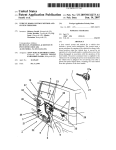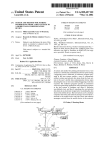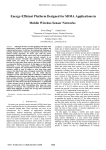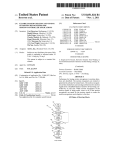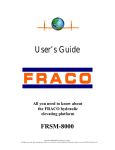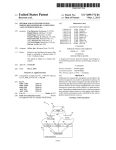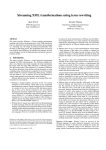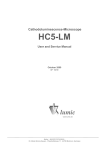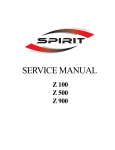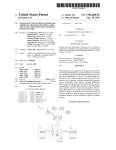Download Handset self diagnostics
Transcript
US008244237B2 (12) United States Patent Peddireddy et a]. (54) HANDSET SELF DIAGNOSTICS (75) Inventors: Sudheer Kumar Peddireddy, Garland, TX (US); Vani Budhati, Garland, TX (US); Sundararajan Chellappan, Garland, TX (US); Rohit Kothari, Garland, TX (US) (73) Assignee: Samsung Electronics Co., Ltd., Notice: Subject to any disclaimer, the term of this patent is extended or adjusted under 35 (21) App1.No.: 11/535,293 (22) Filed: .. 455/423 1/2008 Liu et al. ......... .. .. 455/425 7,369,846 B2 * 5/2008 Koivukangas et al. ..... .. 455/425 7,483,694 B2 * 1/2009 Varanda .......... .. .. 455/423 7,539,503 B2 * 5/2009 Suzuki et al. . .. 455/507 7,555,306 B2 * 6/2009 Liu 7,561,877 B2 * 7,596,373 B2 * 7/2009 Cassett et a1. 9/2009 McGregor et a1. .. 455/423 .. 455/425 1/2010 Soukup et al. .. 370/252 7,778,260 B2 * 2003/0148758 A1* 2004/0235459 A1* 2006/0046647 A1* Sumler et a1. ............ .. 455/67.11 Ward et al. . .. 455/423 ............. .. 8/2010 Sturniolo et al. 8/2003 McMullin 11/2004 Juntunen .. 370/401 .. 455/415 .. 455/414.1 3/2006 Parikh et al. 455/11.1 12/2006 Anderton 2007/0117560 A1* 5/2007 Pora et a1. .. 2007/0197206 8/2007 Olson et al. A1* .. 455/522 .. 455/423 .. 455/423 ....... 2008/0084992 A1* 4/2008 Peddireddy et al. 2009/0143059 A1* 6/2009 . . . .. 455/423 379/433.01 Britt et a1. ................... .. 455/419 OTHER PUBLICATIONS Prior Publication Data US 2008/0084993 A1 Patent application entitled “Remote Handset Diagnostics,” ?led Sep. 26, 2006, as US. Appl. No. 11/535,283. Apr. 10, 2008 * cited by examiner Int. Cl. H04 W24/00 (52) (58) Fok et al. 7,321,766 B2 * Sep. 26, 2006 (65) (51) 4/2007 6/2007 10/2007 2006/0281452 A1* U.S.C. 154(b) by 1247 days. Aug. 14, 2012 7,206,548 B1* 7,228,129 B1 * 7,283,816 B2 * 7,646,725 B1* SuWon-si (KR) (*) US 8,244,237 B2 (10) Patent N0.: (45) Date of Patent: (2009.01) Primary Examiner * Aj it Patel US. Cl. ....... .. 455/425; 455/423; 455/420; 455/418 Assistant Examiner * Ronald Eisner Field of Classi?cation Search ........ .. 455/4l8i420, 455/4234125, 55014560 See application ?le for complete search history. (56) includes a handset and a diagnostic engine on the handset to References Cited obtain diagnostic data for the handset. The system also includes an application on the handset, and the application U.S. PATENT DOCUMENTS 6,567,674 B1* 5/2003 Fujiwara ..................... .. 455/557 6,836,670 B2 * 12/2004 Castrogiovanni et a1 7,024,187 B2 * 7,047,004 B1 * 4/2006 5/2006 (57) ABSTRACT A system for handset self diagnostics is provided. The system 455/558 includes at least one user interface that uses the diagnostic data to assist a user of the handset to operate the handset. Moles et al. ......... .. 455/423 Tolbert, II ................... .. 455/425 20 Claims, 6 Drawing Sheets 100 CarrierS stern 124 Handset 102 Customer Service System 122 Handset A - lication 106 Handset User interfaces 108 Wireless Network 120 Carrier Dianostic Comuter 1Z8 Diagnostic Component 130 ll Diagnostic Engine 104 Encoder 132 User Manual 140 Comnuter 1 10 Corn uterA lication 112 Decoder 134 Intemet 126 Knowledge Base 116 Computer User Interfaces 1 14 Knowledge Base 116 Proxy Component 1 18 Mann faclurer S stem 136 Manufacturer Diauostic Com Liter 138 Diagnostic Component 130 Encoder 132 Decoder 1 34 Knowledge Base 116 US. Patent Aug. 14, 2012 US 8,244,237 B2 Sheet 1 0f 6 100 Carrier System 124 Customer Service System 122 Handset 102 Handset Application 106 Handset User Interfaces 108 Wireless Network 120 Carrier Diagnostic Computer 128 Diagnostic Component 130 Diagnostic Engine 104 Encoder 132 User Manual 140 Decoder 134 1 Computer 1 1 0 Computer Application 1 12 Computer User Interfaces 1 14 lntemet 126 Knowledge Base 1 16 Knowledge Base 116 Proxy Component 1 18 Manufacturer System 136 Manufacturer Diagnostic Comguter 138 Diagnostic Component 130 Encoder 132 Decoder 134 Knowledge Base 116 Fig. 1 US. Patent Aug. 14, 2012 Sheet 2 on Select Module 206 Camera 210 US 8,244,237 B2 Select Problem Current ?ash Area 220 setting is off. = _ Do you want to Resolution 222 SMS 212 Pix Message 214 D'lagnos t'1C5 202 V owe ' Call 216 User Manual 204 Phonebook 218 tum on ‘he —* ?ash'2 232 Flash 224 No 234 Zoom 226 Shutter Sound 228 Y es 236 v Fun Frame 230 I Reporting problem to User Manual User Manual customsr service_ Query 208 glamergsilash A representative will Please input your ‘ Gnu contact you. 238 problem 248 Camera Flash - Camera ?ash set to Camera ?ash not on enables ?ash - on. Please start working 250 off disables ?ash camera and check ls camera ?ash 256 ?ash operation. working now? ON 258 240 242 Entcr 7-5~'2 _ Flash not OFF 26) working. 244 Flash working. 246 Fig. 2 US. Patent Aug. 14, 2012 Sheet 3 of6 Obtain diagnostic data for handset. 302 i Obtain settings data and user manual data for handset. 304 it When the diagnostic data, settings data, and manual data are unable to assist the user to remedy the handset issue, communicating with customer service via the user computer as a proxy. 306 Fig. 3 US 8,244,237 B2 US. Patent Aug. 14, 2012 Sheet 4 on US 8,244,237 B2 [WU 406 5 408 )E 410’ JL )[ 1% [D Fig. 4 US. Patent Aug. 14, 2012 Sheet 5 of6 US 8,244,237 B2 ANTENNA & FRONT END 5062 1% , i RF TRANSCEIVER 508/“ 512; MICROPHONE 514; EARP'ECE 516; HEADSET i ~+ ANALOG BASEBAND PROCESSING 510) 504; MEMORY <+ 520; CARD 5 H DSP ” USB I/O 522 502’ 9 IFC 524 I I I I: ‘I I, CAMERA GPS TOUCH sCREEN/ 'NFRARED LCD CONTROLLER CONTROLLER 538) 526; VIBRATOR +— 532) 528; KEYPAD —+ TOUCH SCREEN LCD 518) $ j: 536) 1: 530) CCDCAMERA 534) Fig. 5 i _____________________________________ "-1 l WEB } : MEDIA JAVA DIAGNOsTIC I l ENGINE I04J I I APPLICATION MANAGEMENT SERVICES II BROWSER PLAYER 608) 610J l 606; I 604 APPLETS 612j I OPERATING SYSTEM (DRIVERS) |____ 6023 _ _ _ _ _ _ _ _ _ _ _ _ — _ _ Fig. 6 _ _ _ _ _ _ _ _ _ : a _ _ _ _ _ _ _ _ __l US. Patent 780 Aug. 14, 2012 Sheet 6 of6 US 8,244,237 B2 . DO 790 Secondary Storage 784 I RAM ‘__> Processor ‘w’ 788 782 ROM I Network 792 786 US 8,244,237 B2 1 2 These and other features and advantages Will be more HANDSET SELF DIAGNOSTICS clearly understood from the folloWing detailed description taken in conjunction With the accompanying draWings and CROSS-REFERENCE TO RELATED APPLICATIONS claims. BRIEF DESCRIPTION OF THE DRAWINGS Not applicable. For a more complete understanding of the present disclo sure and the advantages thereof, reference is noW made to the STATEMENT REGARDING FEDERALLY SPONSORED RESEARCH OR DEVELOPMENT folloWing brief description, taken in connection With the accompanying draWings and detailed description, Wherein Not applicable. like reference numerals represent like parts. FIG. 1 shoWs a handset self diagnostics system according REFERENCE TO A MICROFICHE APPENDIX to an embodiment of the present disclosure. FIG. 2 shoWs a block diagram of a handset user interface according to an embodiment of the present disclosure. FIG. 3 shoWs a How chart of a method for handset self Not applicable. BACKGROUND A handset may refer to a mobile phone, a Wireless handset or telephone, a pager, a personal digital assistant, a portable 20 FIG. 4 shoWs an illustrative Wireless communications sys computer, a tablet computer, or a laptop computer. When a user of the handset needs assistance in operating a handset, tem. the user may contact a customer service center for a telecom munications netWork carrier. The customer service center diagnostics according to an embodiment of the present dis closure. 25 FIG. 5 shoWs a block diagram of an illustrative handset. FIG. 6 shoWs a diagram of an illustrative softWare con?gu ration for a handset. may only provide certain assistance to the user, Which may be limited When the handset is not physically present at the FIG. 7 shoWs an exemplary general purpose computer system suitable for implementing the several embodiments of customer service center. If the customer service center cannot the disclosure. assist the user in operating the handset, the customer service center may send the handset to the handset manufacturer, and may charge the handset manufacturer for the return. Also, customer satisfaction may decrease When the handset is at the customer service center or at the handset manufacturer. Ser vicing the handset at the customer service center or at the handset manufacturer may create expenses for the netWork 30 DETAILED DESCRIPTION OF THE PREFERRED EMBODIMENTS It should be understood at the outset that although an exem 35 plary implementation of one embodiment of the present dis closure is illustrated beloW, the present system may be imple mented using any number of techniques, Whether currently carrier, the handset manufacturer, or both. knoWn or in existence. The present disclosure should in no Way be limited to the exemplary implementations, draWings, SUMMARY In one embodiment, a system for handset self diagnostics is provided. The system includes a handset and a diagnostic engine on the handset to obtain diagnostic data for the hand set. The system also includes an application on the handset, 40 but may be modi?ed Within the scope of the appended claims along With their full scope of equivalents. To reduce expenses and customer dissatisfaction When a handset is at a customer service center or at a handset manu and the application includes at least one user interface that uses the diagnostic data to assist a user of the handset to facturer, embodiments of the present disclosure enable a handset user to perform self-diagnosis on a handset. The user may use the handset to access diagnostic data to correct a operate the handset. In another embodiment, a system for handset self diagnos tics is provided. The system includes a handset operable for use by a user for Wireless communication. The system also handset problem. Unlike typical settings information, the present system enables the user to access diagnostic data on 50 includes a diagnostic engine to obtain diagnostic data for the computer of the user, With the computer in communication 55 handset to operate the handset. In yet another embodiment, a method for handset self diagnostics is provided. When a handset is inoperable to communicate via a carrier Wireless netWork, a computer of a user of the handset communicates With the handset. An appli 60 cation is selected using the computer to obtain diagnostic data from the handset to enable the handset to communicate via the carrier Wireless netWork. When the application cannot enable the handset to communicate via the carrier Wireless netWork, the computer of the user is used as a proxy to promote com munication betWeen the handset and a customer service sys tem of the carrier to attempt to resolve the issue. the handset. An example of such diagnostic data may be codes or information related to dropped calls. Such information is maintained on the handset, but not readily available to the handset user Without an application provided by some embodiments of the present disclosure. handset. Additionally, the system includes an application on a With the handset. The application includes at least one user interface that uses the diagnostic data to assist the user of the and techniques illustrated beloW, including the exemplary design and implementation illustrated and described herein, 65 In some embodiments, the handset user may use a personal computer communicating With the handset to correct handset problems. For example, if the user cannot correct problems by using the handset, the user may use the personal computer to correct the problem. In other embodiments of the present disclosure, When the handset has a problem making calls or cannot otherWise communicate With the Wireless telecommu nications netWork, the user may use the personal computer as a proxy to promote communication betWeen the handset and a customer service system of the carrier. This communication With the customer service system, either directly or via the user’ s personal computer, may assist in correcting the handset communication or other problems. US 8,244,237 B2 3 4 FIG. 1 depicts a handset self diagnostics system 100 according to an embodiment of the present disclosure. The system 100 includes a handset 102, Which includes the diag nostic engine 104. The handset 102 is described in more detail below With reference to FIGS. 4-6. The system 100 shoWs only one handset for the purpose of illustration, but the system 100 may include any number of handsets. The handset 102 also includes a handset application 106, handset 102. The knoWledge base 116 on the computer 110 may include or be able to doWnload additional or updated records regarding speci?c handset problems to Which the handset application 106 may not have access. Additionally, the computer 110 includes a proxy compo nent 118. When the handset 102 is inoperable or unable to communicate With a Wireless netWork 120, the user of the handset 102 may use the computer 110 to communicate With the handset 102. The user may use the proxy component 118 on the computer 110 to promote communication betWeen the handset 102 and a customer service system 122 for a telecom munications carrier system, or carrier system 124. The proxy component 118 alloWs the carrier system 124 access to the handset 102 via the Wireless netWork 120, or an alternative communication system, such as the Internet 126. Which includes a handset user interface 108. The handset application 106 is softWare that includes the handset user interface 108 Which may be a GUI (graphical user interface) that enables a user of the handset 102 to access diagnostic data from the diagnostic engine 104 on the handset 102 to assist the user to operate the handset 102. Diagnostic data is infor mation related to the operation of the handset 102, and may include, but is not limited to, dropped calls information, error logs, records of problems, CPU or processor activity or usage, system level, or information other than handset settings. Handset settings and settings related information are typi cally more readily accessible to users than diagnostic data. 20 The handset 102 may also include a user manual 140. The user manual 140 may be located on the handset 102, on the computer 110, and/or on a diagnostic computer. A compre hensive user manual 140 for the handset 102 is not usually available on handsets such mobiles phones or personal digital 25 assistants. Similar to help options on personal computer applications, embodiments of the present disclosure provide the user manual 140 on the handset 102, the computer 110, or a diagnostic computer so that a handset user has it readily available as a reference, in lieu of a paper version of the user 30 manual 140 Which is typically not kept With the handset 102. 35 Which may be the handset user’s computer, but is not a com puter operated by the Wireless telecommunication provider or handset manufacturer. The handset 102 may communicate With the computer 110 Wirelessly or by a Wired connection. The computer 110 includes a computer application 112, 40 Which includes a user interface 114. The computer applica tion 112 includes the computer user interface 114 to enable the user of the handset 102 to access diagnostic data from the diagnostic engine 104 on the handset 102 to assist the user to operate the handset 102. The computer application 112 may include components similar to the components in the handset application 106. HoWever, the computer application 112 may 45 50 example, the handset may not have been provided With the 55 speci?c or additional capabilities to access different systems in the handset 102. The computer 110 also includes a knoWledge base 116. The knoWledge base 116 is a database that may include records diagnostic data that is proprietary and speci?c to a particular handset. The manufacturers may develop speci?c tools to communicate With the proprietary diagnostic engine on each of the different handsets they manufacture. These systems are typically not provided to the telecommunications carriers. According to the present disclosure, the encoder 132 and decoder 134 may be systems provided by the manufacturer that are capable of communicating With the diagnostic engine 104 on the handset 102, either directly or indirectly. In some embodiments, the diagnostic component 130 may be a tool or interface to promote communication With the diagnostic 60 engine 104 by employing the capabilities of the encoder and 65 decoder 132 and 134. That is, multiple encoders and decoders 132 and 134, each capable of communicating With different diagnostic engines 104 on different handsets 102, might be provided on the carrier’s diagnostic computer 128. Although only one encoder and decoder 132, 134 are shoWn, multiple the computer 110 uses to assist the user With each speci?c handset problem. Each time a handset problem is solved, the computer 110 may update the knoWledge base 116. Although not shoWn in FIG. 1, the handset 102 may also include the knoWledge base 116. HoWever, the knoWledge base 116 on the handset 1 02 may be limited relative to the knoWledge base 116 on the computer 110 because of storage limitations on the set may include a different diagnostic engine and conse quently each handset may require a different application or interface to communicate With the diagnostic engine of that handset. Also each diagnostic engine may generate or record most recent or updated diagnostic information or testing capabilities. The computer application 112 may have or be regarding speci?c handset problems and speci?c actions that handset application 106 may not have. Also, the carrier diag nostic computer 128 may have speci?c capabilities to access different or additional systems in the handset 102. The carrier diagnostic computer 128 includes a diagnostic diagnostic component 130 may be, for example, a softWare application used to promote communicate With the diagnostic engine 104. It should be appreciated that each different hand to execute additional diagnostic tests on the handset 102. For able to easily obtain, such as by doWnloading via the Internet, nents, such as the knoWledge base 116, similar to the compo nents in the computer 110. HoWever, the carrier diagnostic computer 128 may have additional or updated diagnostic information or capabilities that the computer 110 and the component 130, an encoder 132 and a decoder 134. The provide additional assistance and functionality beyond that of the handset application 1 06. For example, the computer appli cation 112 may provide or instruct the diagnostic engine 104 104 and assisting the user to operate the handset 102. The diagnostic computer 128 may assist the user to operate the handset 102 by sending softWare or ?rmware to the handset 102. The carrier diagnostic computer 128 is a diagnostic computer used by the carrier system 124. The user of the handset 102 may communicate With the customer service system 122 to obtain assistance With the handset 102. The customer service system 122 may use the carrier diagnostic computer 128 to diagnose the handset 102 to assist the user With the handset 102. The carrier diagnostic computer 128 may include compo The handset 102 could internally use SMS (Short Message Service) for various functions including retrieving and pre senting the user manual 140 and/ or other applications. The handset 102 may communicate With a computer 110, The handset 102 may also communicate directly With the carrier system 124 through the Wireless netWork 120. The carrier system 124 includes the customer service system 122 and a carrier diagnostic computer 128. A diagnostic computer is a computer for communicating With the diagnostic engine encoders and decoders 132,134 might be present. The diag nostic component 130 might also provide a common GUI US 8,244,237 B2 5 6 (graphical user interface) for customer service representa tives to Work the multiple handsets 102 and diagnostic be displayed on the handset 102 by the handset application 106. The user interfaces depicted in FIG. 2 are examples of the handset user interfaces 108 that may be displayed in engines 104. The diagnostic component 130, along With other systems, might provide the communication capabilities to promote response to a sequence of user selections made by a user engine 104. For example, the diagnostic component 130 might send scripts or other inputs to the diagnostic engine 104 experiencing a problem With a camera, for example, a ?ash problem for a camera. Although ?ash related problems may be diagnostics information or user settings depending on the handsets, ?ash problems are provided as an example of a that Were obtained from the encoder 132. Communications diagnostic problem that may require the use of diagnostic remote communication With the handset 102 and diagnostic received by the diagnostic component 130 from the diagnos data to correct. HoWever, as used herein, diagnostic data is tic engine 104 might be referred to the decoder 134 for inter any information that is normally not available to a user pretation. The encoder 132 may change signals, communica through standard settings, and may include, but is not limited to, information about an operating system, hardWare, soft tions, or requests from the diagnostic component 130 into code, or signals understandable to the diagnostic engine 104. Similarly, the decoder 134 may change code, data, or instruc tions received from the diagnostic engine 104 back into data Ware, ?rmWare, system serial numbers, dropped calls, other proprietary information, or any other non-setting data. The ?rst options that may be displayed to the user of the handset 102 by the handset application 106 may be a diag nostics 202 option and a user manual 204 option. By selecting the diagnostics 202 option, the handset application 106 may understandable to a diagnostic computer 128 or diagnostic component 130. The diagnostic component 130, encoders 132, and/or decoders 134 might be provided With a standard interface or API (application programming interface) so different manu facturers’ encoders and decoders 132, 134 may communicate 20 such as the options displayed under a “select module” 206 heading. With the diagnostic component 130. Other Ways of handling the communication betWeen the diagnostic component 130, encoders 132, and/or decoders 134 to promote communica display the diagnostic portion of the handset application 106, Which provides further options related to handset diagnostics, The options displayed under the “select module” 206 head 25 tion With the diagnostic engine 104 Will readily suggest them ing may include a camera 210 option, a SMS 212 option, a pix message 214 option, a voice call 216 option, and a phonebook selves to one skilled in the art in light of the present disclo sure. Additional information on the diagnostic component 218 option. By selecting the camera 210 option, the user may 130, encoders 132, and/or decoders 134 is provided in co troller. By selecting the SMS 212 option, the user may select further options related to a short message service for provid pending U.S. patent application Ser. No. ll/535,283, ?led Sep. 26, 2006, entitled “Remote Handset Diagnostics,” by select further options related to a camera and a camera con 30 ing alphanumeric messaging. By selecting the pix message Sudheer Kumar Peddireddy, et al ., referenced above, Which is 214 option, the user may select further options related to incorporated herein by reference. digital picture messages. By selecting the voice call 216 option, the user may select further options related to audio The carrier diagnostic computer 128 may use the knoWl edge base 116 accessed by the carrier diagnostic computer 35 the user may select further options related to a database of telephone numbers, associated names and so on. For example, if the user selects the camera 210 option, the 128 to assist the user to operate the handset 102. Each time a handset problem is solved, the carrier diagnostic computer 128 may update the knowledge base 116 accessed by the carrier diagnostic computer 128. The handset 102 user may also obtain assistance directly from the manufacturer via the Wireless netWork 120, or, When handset application 106 may display a “select problem area” 40 option, and a fun frame 230 option. By selecting the resolu tion 222 option, the user may select further options related to the lntemet 126. The manufacturer system 136 may include a manufacturer diagnostic computer 138, Which may be similar to the carrier diagnostic computer 128. The manufacturer diagnostic computer 138 is a diagnostic computer used by the handset manufacturer. The manufacturer diagnostic com puter 138 may include components substantially similar to 45 the components in the carrier diagnostic computer 128, such as the diagnostic component 130, the encoder 132, the decoder 134, and the knoWledge base 116. 50 the level of detail for digital pictures taken by the camera. By selecting the ?ash 224 option, the user may select further options related to the light produced by the ?ash to help illuminate a scene for photographing. By selecting the Zoom 226 option, the user may select further options related to adjusting the lens magni?cation. The shutter sound 228 option may provide options related to the sound made by the device When taking a picture. The fun frame 23 0 may provide options related to a selection of digital frames that may be The handset manufacturer may have additional or updated different systems or functionality in the handset 102. The knoWledge base 116 on the manufacturer diagnostic com puter 138 may include additional or updated records regard 220 heading. The options displayed under the “select problem area” 220 heading may include a resolution 222 option, a ?ash 224 option, a Zoom 226 option, a shutter sound 228 the handset 120 is inoperable, may communicate indirectly With the manufacturer system 136 using the computer 110 via diagnostic information or capabilities that the carrier diag nostic computer 128, the computer 110, or the handset appli cation 106 may not have. Further, the manufacturer diagnos tic computer 138 may have speci?c capabilities to access messages and call settings. By selecting the phonebook 218, displayed around the digital pictures taken by the camera. 55 If the user selects the ?ash 224 option, the handset appli cation 106 may display, for example, the heading “Current ?ash setting is off. Do you Want to turn on the ?ash?” 232. The handset application 106 may respond to the selection of the ?ash 224 option by executing the ?rst diagnostic engine 104, 60 Which may obtain diagnostic data for the handset 102, such as ing speci?c handset problems that the carrier diagnostic com puter 128, the computer 110, or the handset application 106 handset 102 diagnostic data. The diagnostic data obtained by the diagnostic engine 104 may indicate that the ?ash option may not have. Turning noW to FIG. 2, a block diagram of a handset user for the camera is inoperative because the ?ash setting is set to off. In response to this indication, the handset application 106 may display the message “Current ?ash setting is off. Do you interface is depicted according to an embodiment of the present disclosure. These illustrative handset user interfaces may be examples of the handset user interfaces 108 that may 65 Want to turn on the ?ash?” 232. In response to the message 232, the user may select the no 234 or the yes 236 options. US 8,244,237 B2 8 7 the handset application 106 responds to this user selection by displaying the message “Reporting problem to customer ser vice. A representative Will contact you.” 238. At this point, the handset 102 reports the ?ash problem for the camera to the customer service system 122, and the process depicted in FIG. 2 terminates. Although not shoWn, the interfaces illus trated in FIG. 2 may also include the settings interfaces and capabilities typically found on handsets 102. The user may select no 234 if the user Wants the ?ash to stay off or if the user has already tried unsuccessfully to turn the ?ash on. The handset application 106 might respond to the user selection of the no 234 option by displaying a message “Reporting problem to customer service. A representative Will contact you.” 238. At this point, the handset 102 may report the ?ash problem for the camera to the customer ser vice system 122. A customer service representative may respond by contacting the user immediately, or at a later time. Alternatively, the user may select the yes 236 option in response to the message “Current ?ash setting is off. Do you Turning noW to FIG. 3, a ?oWchart of a method for handset self diagnostics is depicted according to an embodiment of the present disclosure. The method for handset self diagnos tics may begin When the user accesses the handset application 106 With a request for assistance to operate the handset 102. The user may request assistance to operate the handset 102 because the user may lack knowledge to operate all the vari ous features of the handset 102. Such a request for assistance Want to turn on the ?ash?” 232. For this example, the handset application 106 responds to this selection by displaying a message “Camera ?ash set to on. Please start camera and check ?ash operation.” 240. After displaying the message 240, the handset application 106 displays a message “Is cam era ?ash Working noW?” 242 and both a Flash not Working 244 option and a Flash Working 246 option, might then be displayed. If the user responds to the message 242 by select ing the Flash Working 246 option, the process depicted in 20 FIG. 2 terminates. If the user responds to the message 242 by selecting the ?ash not Working 244 option, the handset appli cation 106 responds to this user selection by displaying the message “Reporting problem to customer service. A repre sentative Will contact you.” 238. After reporting the problem to customer service, the process depicted in FIG. 2 termi either in varying orders depending on the selections made by the user of the handset 102. 25 nates. By selecting the user manual 204 option, the handset appli cation 106 may display the help portion of the handset appli cation 106, Which includes further options related to user manual data, such as the options displayed under a “user manual query” 208 heading. User manual data is a set of 30 manual data are unable to assist the user in resolving the handset issue, the user may communicate With customer ser 35 option, the handset application 106 may display the options vice regarding the problem. When the handset is unable to communicate, or make a call, the user may connect the hand set to the user’s computer 110 Wirelessly or via Wired con nection and thereafter employ the user’s computer 110 as a headed by the mes sage “user manual query” 208. The options headed by the message “user manual query” 208 may include a message “please input your problems” 248. In response to the message 248, the user may enter a response “camera ?ash At block 302, the user may obtain diagnostics data by accessing the handset application 1 06 and user interfaces 108. The diagnostic engine 104 on the handset 102 is able to obtain diagnostic data from the handset Which may be used to resolve the handset related problems. At block 304, the user may obtain settings data and/or user manual data to assist the user in resolving the problem With the handset. Finally, at block 306, When the diagnostics data, settings data and information provided by the handset manufacturer that instructs the user hoW to operate the handset 102. In another example, if the user selects the user manual 204 may often be met by offering the user access to the user manual 140. The user may also request assistance to operate the handset 102 due to a handset problem, Which may be caused by handset softWare, handset hardWare, or a combi nation of the handset softWare and the handset hardWare. The boxes in the ?oWchart depicted in FIG. 3 may be executed 40 proxy to remotely communicate With the carrier system 124 and customer service to obtain assistance in resolving the not Working” 250, and select an enter 252 option. In response to the user selecting the enter 252 option, the handset appli problem. cation 106 obtains user manual data from the user manual 140. The user manual 140 may be located on the handset 102, on the computer 110, or on a diagnostic computer. The user and information collected may be stored on a storage device It should be appreciated that the diagnostic and other data on the handset 102 and periodically retrieved and communi 45 manual 140 may be accessed directly, or may be accessed cated to other systems. Alternatively, the diagnostic and other data and information might be collected from the handset 102 indirectly through the computer 110 or through the computer and then transmitted Without being stored, or some data or 110 and the proxy component 118. In response to the user selecting the enter 252 option after portions of the data might be stored, temporarily or otherWise, entering the response 250, the handset application 106 may query the data from the user manual 140 and display a mes sage “user manual camera ?ash menu” 254. The user inter face headed by the mes sage “user manual camera ?ash menu” 254 may include a message “camera ?ash4on enables ?ash4off disables ?ash” 256, and both an on 258 option and an off 260 option. In response to the message 256, the user may select the on 258 option to set the ?ash on for the camera. In response to the user selecting the on 258 option, the hand 50 operable for implementing aspects of the present disclosure, 55 but the present disclosure should not be limited to these implementations. Though illustrated as a mobile phone, the handset 102 may take various forms including a Wireless handset, a pager, a personal digital assistant (PDA), a portable computer, a tablet computer, or a laptop computer. Many suitable handsets combine some or all of these functions. In set application 106 may display the message “Camera ?ash set to on. Please start camera and check ?ash operation.” 240. and then transmitted to the relevant systems. FIG. 4 shoWs a Wireless communications system including the handset 102. FIG. 4 depicts the handset 102, Which is 60 After displaying the message 240, the handset application 106 displays the message “Is camera ?ash Working noW”? 242 and both a ?ash not Working 244 option and a ?ash some embodiments of the present disclosure, the handset 102 is not a general purpose computing device like a portable, laptop or tablet computer, but rather is a special-purpose depicted in FIG. 2 terminates. If the user responds to the communications device such as a mobile phone, Wireless handset, pager, or PDA. The handset 102 includes a display 402 and a touch-sensi tive surface or keys 404 for input by a user. The handset 102 may present options for the user to select, controls for the user message 242 by selecting the ?ash not Working 244 option, to actuate, and/or cursors or other indicators for the user to Working 246 option. If the user responds to the message 242 by selecting the ?ash Working 246 option, the process 65 US 8,244,237 B2 10 direct. The handset 1 02 may further accept data entry from the user, including numbers to dial or various parameter values for con?guring the operation of the handset. The handset 102 receive e-mail or text messages. The input/output interface 518 interconnects the DSP 502 and various memories and interfaces. The memory 504 and the removable memory card may further execute one or more software or ?rmware appli 520 may provide software and data to con?gure the operation cations in response to user commands. These applications of the DSP 502. Among the interfaces may be the USB interface 522 and the infrared port 524. The USB interface may con?gure the handset 1 02 to perform various customiZed 522 may enable the handset 102 to function as a peripheral functions in response to user interaction. Among the various applications executable by the handset device to exchange information with a personal computer or 102 are a web browser, which enables the display 402 to show a web page. The web page is obtained via wireless commu nications with a cell tower 406, a wireless network access node, or any other wireless communication network or sys other computer system. The infrared port 524 and other tem. The cell tower 406 (or wireless network access node) is coupled to a wired network 408, such as the Internet. Via the wireless link and the wired network, the handset 102 has and/or wireless base stations. The input/output interface 518 may further connect the DSP 502 to the vibrator 526 that, when triggered, causes the optional ports such as a Bluetooth interface or an IEEE 802.11 compliant wireless interface may enable the handset 102 to communicate wirelessly with other nearby handsets access to information on various servers, such as a server 410. handset 102 to vibrate. The vibrator 526 may serve as a The server 41 0 may provide content that may be shown on the mechanism for silently alerting the user to any of various display 402. events such as an incoming call, a new text message, and an appointment reminder. FIG. 5 shows a block diagram of the handset 102. The handset 102 includes a digital signal processor (DSP) 502 and 20 The keypad 528 couples to the DSP 502 via the interface a memory 504. As shown, the handset 102 may further include an antenna and front end unit 506, a radio frequency 518 to provide one mechanism for the user to make selections, (RF) transceiver 508, an analog baseband processing unit 510, a microphone 512, an earpiece speaker 514, a headset 102. Another input mechanism may be the touch screen LCD 530, which may also display text and/or graphics to the user. The touch screen LCD controller 532 couples the DSP 502 to enter information, and otherwise provide input to the handset port 516, an input/output interface 518, a removable memory card 520, a universal serial bus (USB) port 522, an infrared port 524, a vibrator 526, a keypad 528, a touch screen liquid crystal display (LCD) with a touch sensitive surface 530, a touch screen/LCD controller 532, a charge-coupled device 25 (CCD) camera 534, a camera controller 536, and a global 30 the touch screen LCD 530. The CCD camera 534 enables the handset 102 to take digital pictures. The DSP 502 communicates with the CCD camera 534 via the camera controller 536. The GPS sensor The DSP 502 or some other form of controller or central processing unit operates to control the various components of the handset 102 in accordance with embedded software or ?rmware stored in memory 504. In addition to the embedded software or ?rmware, the DSP 502 may execute other appli cations stored in the memory 504 or made available via infor 538 is coupled to the DSP 502 to decode global positioning system signals, thereby enabling the handset 102 to determine its position. Various other peripherals may also be included to provide additional functions, e.g., radio and television recep positioning system (GPS) sensor 538. tion. 35 FIG. 6 illustrates a software environment 602 that may be network communications. The application software may comprise a compiled set of machine-readable instructions that con?gure the DSP 502 to provide the desired function ality, or the application software may be high-level software instructions to be processed by an interpreter or compiler to 40 implemented by the DSP 502. The DSP 502 executes oper ating system drivers 604 that provide a platform from which the rest of the software operates. The operating system drivers 604 provide drivers for the handset hardware with standard iZed interfaces that are accessible to application software. The indirectly con?gure the DSP 502. 45 mation carrier media such as portable data storage media like the removable memory card 520 or via wired or wireless operating system drivers 604 include application manage ment services (“AMS”) 606 that transfer control between applications running on the handset 102. Also shown in FIG. 6 are a web browser application 608, a media player applica tion 610, Java applets 612, and the diagnostic engine 104. The The antenna and front end unit 506 may be provided to web browser application 608 con?gures the handset 102 to convert between wireless signals and electrical signals, enabling the handset 102 to send and receive information into forms and select links to retrieve and view web pages. operate as a web browser, allowing a user to enter information The media player application 610 con?gures the handset 102 from a cellular network or some other available wireless communications network. The RF transceiver 508 provides 50 frequency shifting, converting received RF signals to base applets 612 con?gure the handset 102 to provide games, utilities, and other functionality. The diagnostic engine 104 is band and converting baseband transmit signals to RF. The analog baseband processing unit 510 may provide channel equaliZation and signal demodulation to extract information from received signals, may modulate information to create a component that may generate or record information related to the operation of the handset 102 as discussed above. 55 transmit signals, and may provide analog ?ltering for audio signals. To that end, the analog baseband processing unit 510 may have ports for connecting to the built-in microphone 512 and the earpiece speaker 514 that enable the handset 102 to be used as a cell phone. The analog baseband processing unit 510 to retrieve and play audio or audiovisual media. The Java 60 may further include a port for connecting to a headset or other One or more applications or systems described above may be implemented on any general-purpose computer with suf ?cient processing power, memory resources, and network throughput capability to handle the necessary workload placed upon it. FIG. 7 illustrates a typical, general-purpose computer system which may be used as the computer 110, carrier and/or manufacturer diagnostic computers 128, 138 hands-free microphone and speaker con?guration. suitable for implementing one or more embodiments dis The DSP 502 may send and receive digital communica tions with a wireless network via the analog baseband pro cessing unit 510. In some embodiments, these digital com munications may provide Internet connectivity, enabling a closed herein. The computer system 780 includes a processor user to gain access to content on the Internet and to send and 782 (which may be referred to as a central processor unit or 65 CPU) that is in communication with memory devices includ ing secondary storage 784, read only memory (ROM) 786, random access memory (RAM) 788, input/output (I/O) 790 US 8,244,237 B2 11 12 devices, and network connectivity devices 792. The processor The secondary storage 784 is typically comprised of one or limited to the details given herein, but may be modi?ed Within the scope of the appended claims along With their full scope of equivalents. For example, the various elements or compo more disk drives or tape drives and is used for non-volatile storage of data and as an over-?oW data storage device if nents may be combined or integrated in another system or certain features may be omitted, or not implemented. may be implemented as one or more CPU chips. Also, techniques, systems, subsystems and methods RAM 788 is not large enough to hold all Working data. Sec ondary storage 784 may be used to store programs Which are loaded into RAM 788 When such programs are selected for execution. The ROM 786 is used to store instructions and described and illustrated in the various embodiments as dis crete or separate may be combined or integrated With other perhaps data Which are read during program execution. ROM from the scope of the present disclosure. Other items shoWn or discussed as directly coupled or communicating With each other may be coupled through some interface or device, such that the items may no longerbe considered directly coupled to each other but may still be indirectly coupled and in commu systems, modules, techniques, or methods Without departing 786 is a non-volatile memory device Which typically has a small memory capacity relative to the larger memory capacity of secondary storage. The RAM 788 is used to store volatile data and perhaps to store instructions. Access to both ROM 786 and RAM 788 is typically faster than to secondary stor age 784. nication, Whether electrically, mechanically, or otherWise With one another. Other examples of changes, substitutions, 1/0 790 devices may include printers, video monitors, liq and alterations are ascertainable by one skilled in the art and uid crystal displays (LCDs), touch screen displays, key boards, keypads, sWitches, dials, mice, track balls, voice rec could be made Without departing from the spirit and scope ogniZers, card readers, paper tape readers, or other Well knoWn input devices. The netWork connectivity devices 792 may take the form of modems, modem banks, ethernet cards, 20 1. A system for handset diagnostics, comprising: a handset; universal serial bus (U SB) interface cards, serial interfaces, token ring cards, ?ber distributed data interface (FDDI) cards, Wireless local area netWork (WLAN) cards, radio transceiver cards such as code division multiple access (CDMA) and/or a diagnostic engine on the handset con?gured to obtain diagnostic data for the handset from a customer service 25 global system for mobile communications (GSM) radio cessor 782 to communicate With an Internet or one or more 30 35 con?gured to obtain the diagnostic data. 2. The system of claim 1, Wherein the handset is selected from a group consisting of a mobile phone, a Wireless hand 40 ied in a carrier Wave. The baseband signal or signal embodied 45 ductors, in coaxial cables, in Waveguides, in optical media, for example optical ?ber, or in the air or free space. The information contained in the baseband signal or signal embedded in the carrier Wave may be ordered according to different sequences, as may be desirable for either processing or generating the information or transmitting or receiving the set, a personal digital assistant, a portable computer, a tablet computer, and a laptop computer. 3. The system of claim 1, Wherein the diagnostic data includes error logs and dropped calls information Which are accessible to the user of the handset only by the application. 4. The system of claim 1, Wherein the application is con ?gured to use settings data to assist the user to operate the handset. 5. The system of claim 1, Wherein the application is con ?gured to use user manual data to assist the user to operate the 50 information. The baseband signal or signal embedded in the carrier Wave, or other types of signals currently used or here after developed, referred to herein as the transmission medium, may be generated according to several methods Well service system of the carrier Wireless netWork to enable the handset to communicate via the carrier Wireless net Work, the customer service system comprising a tool in the carrier Wave generated by the netWork connectivity 792 devices may propagate in or on the surface of electrical con When said second application is unable to enable the hand set to communicate via the carrier Wireless netWork, using another computer of the user as a proxy to promote communication betWeen the handset and a customer the form of a computer data signal embodied in a carrier Wave Such information, Which may include data or instructions to be executed using processor 782 for example, may be received from and outputted to the netWork, for example, in the form of a computer data baseband signal or signal embod system; and a ?rst application on the handset comprising at least one user interface that is con?gured to use the diagnostic data to assist a user of the handset to operate the handset; a second application on a computer con?gured to: transceiver cards, and other Well-knoWn netWork devices. These netWork connectivity 792 devices may enable the pro intranets. With such a netWork connection, it is contemplated that the processor 782 might receive information from the netWork, or might output information to the netWork in the course of performing the above-described method steps. Such information, Which is often represented as a sequence of instructions to be executed using processor 782, may be received from and outputted to the netWork, for example, in disclosed herein. What is claimed is: handset. 6. The system of claim 1, Wherein the user interface is con?gured to provide an option for the user to contact a carrier customer service system for the handset When the user 55 requires assistance to operate the handset. 7. A system for handset diagnostics, comprising: knoWn to one skilled in the art. a handset; The processor 782 executes instructions, codes, computer programs, scripts Which it accesses from hard disk, ?oppy disk, optical disk (these various diskbased systems may all be considered secondary storage 784), ROM 786, RAM 788, or the netWork connectivity devices 792. While several embodiments have been provided in the present disclosure, it should be understood that the disclosed systems and methods may be embodied in many other spe ci?c forms Without departing from the spirit or scope of the present disclosure. The present examples are to be considered a diagnostic engine on the handset con?gured to obtain diagnostic data for the handset from a customer service as illustrative and not restrictive, and the intention is not to be system; 60 a ?rst application on the handset comprising at least one user interface that is con?gured to use the diagnostic data to assist a user of the handset to operate the handset; and a second application on a computer con?gured to: 65 When said second application is unable to enable the hand set to communicate via the carrier Wireless netWork, using another computer of the user as a proxy to promote US 8,244,237 B2 14 13 15. A method for handset diagnostics, comprising: obtaining, with a diagnostic engine on a handset, diagnos communication between the handset and a customer service system of the carrier wireless network to enable the handset to communicate via the carrier wireless net tic data for the handset from a customer service system; selecting an application on the handset to use the diagnos tic data to assist a user of the handset to operate the work, the customer service system comprising a tool con?gured to obtain the diagnostic data. 8. The system of claim 7, wherein the diagnostic data used handset; when said handset is inoperable to communicate via a to assist the user to operate the handset is further con?gured to be used to assist the user with handset problems. carrier wireless network, communicating with the hand set using a computer of a user of the handset; 9. The system of claim 7, wherein the computer and the selecting an application using the computer to obtain diag handset are con?gured to communicate via a communication channel selected from a group consisting of a wired connec tion, a wireless connection, an infra-red connection, and an no stic data from the handset to enable the handset to communicate via the carrier wireless network; when the application is unable to enable the handset to optical connection. communicate via the carrier wireless network, using the 10. The system of claim 7, further comprising: computer of the user as a proxy to promote communi cation between the handset and a customer service sys a carrier customer service system; and a proxy component con?gured on the computer of the user tem of the carrier wireless network to enable the handset to communicate via the carrier wireless network, the customer service system comprising a tool operable to to promote communication between the handset and the carrier customer service system to enable the carrier customer service system to assist the user to operate the handset. 11. The system of claim 10, wherein the carrier customer 20 the computer. 17. The method of claim 15, wherein the computer of the service system includes a diagnostics component con?gured to communicate with the diagnostic engine on the handset via the computer of the user and the proxy component. 12. The system of claim 10, wherein the diagnostic data includes error logs and dropped calls information which are accessible to the user of the handset only by the application, wherein the application is con?gured to use user manual data to assist the user to operate the handset, and wherein the carrier customer service system is con?gured to use the diag user of the handset is coupled to communicate with the hand 25 diagnostic engine, the encoder operable to encode requests red connection, and an optical connection. 18. The method of claim 15, wherein the application includes a help portion and a diagnosis portion, wherein the 30 the application and settings data to enable the handset to communicate via the carrier wireless network, and wherein the help portion includes user manual data for the handset. 35 19. The method of claim 18, wherein the application on the computer accesses a knowledge base for the handset to enable the handset to communicate via the carrier wireless network. 40 a customer service system of the manufacturer of the hand 20. The method of claim 15, wherein when the handset is operable to communicate via the carrier wireless network, the method further includes: the user selecting the application using the computer to assist the user to operate the handset; and when the user still requires assistance to operate the set; and a proxy component con?gured on the computer of the user to promote communication between the handset and the customer service system of the manufacturer to enable the customer service system of the manufacturer to assist the user to operate the handset. diagnosis portion includes error logs and dropped calls infor mation which are accessible to the user of the handset only by for diagnostics data from the carrier customer service system to the diagnostics engine and the decoder operable to decode the diagnostic data received by the carrier customer service system from the handset diagnostic engine. 14. The system of claim 7, further comprising: set via a communication channel selected from a group con sisting of a wired connection, a wireless connection, an infra nostic data to assist the user to operate the handset. 13. The system of claim 10, further comprising an encoder and a decoder con?gured to promote communication between the carrier customer service system and the handset obtain the diagnostic. 16. The method of claim 15, wherein the application is on handset, selecting for the handset to communicate 45 with the customer service system of the carrier wire less network to assist the user to operate the handset. * * * * *















